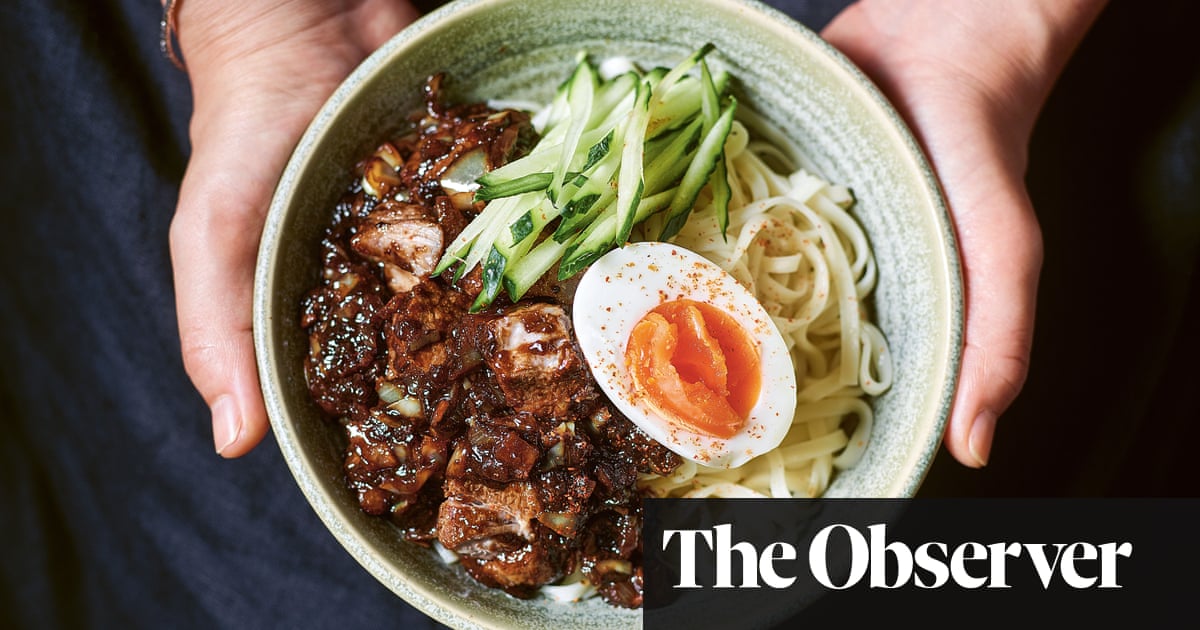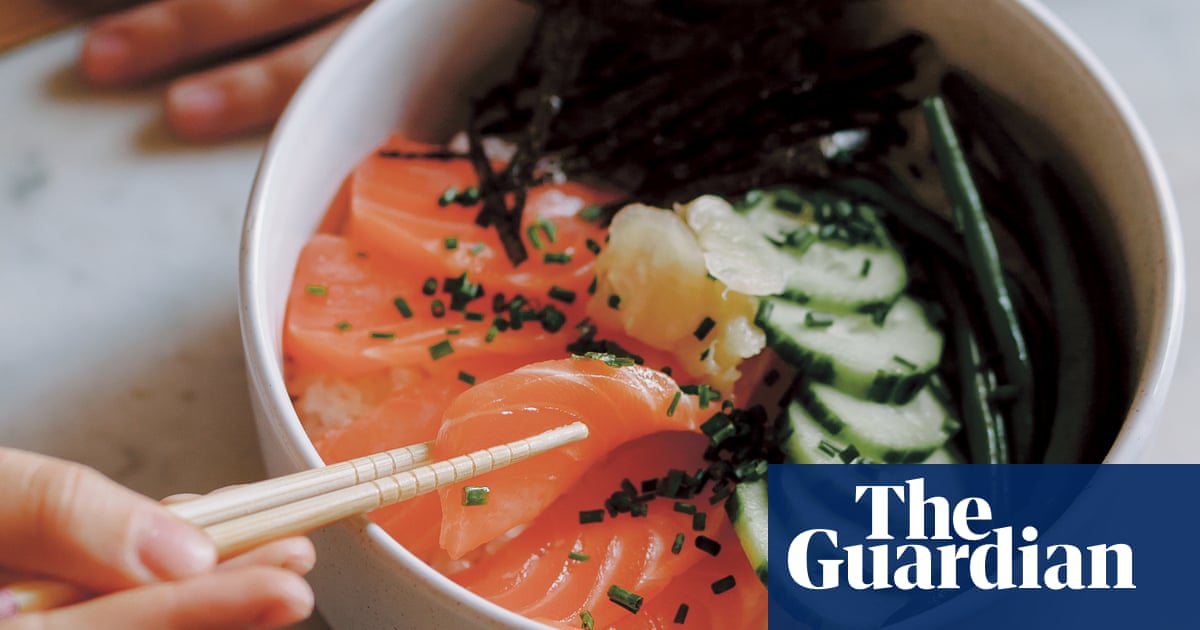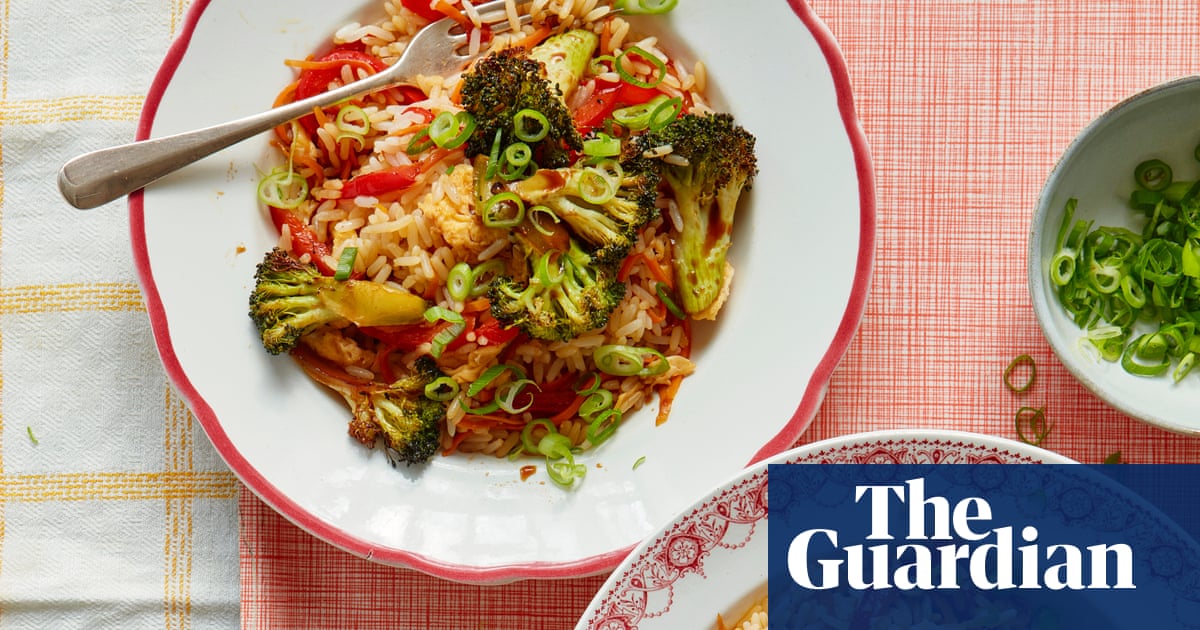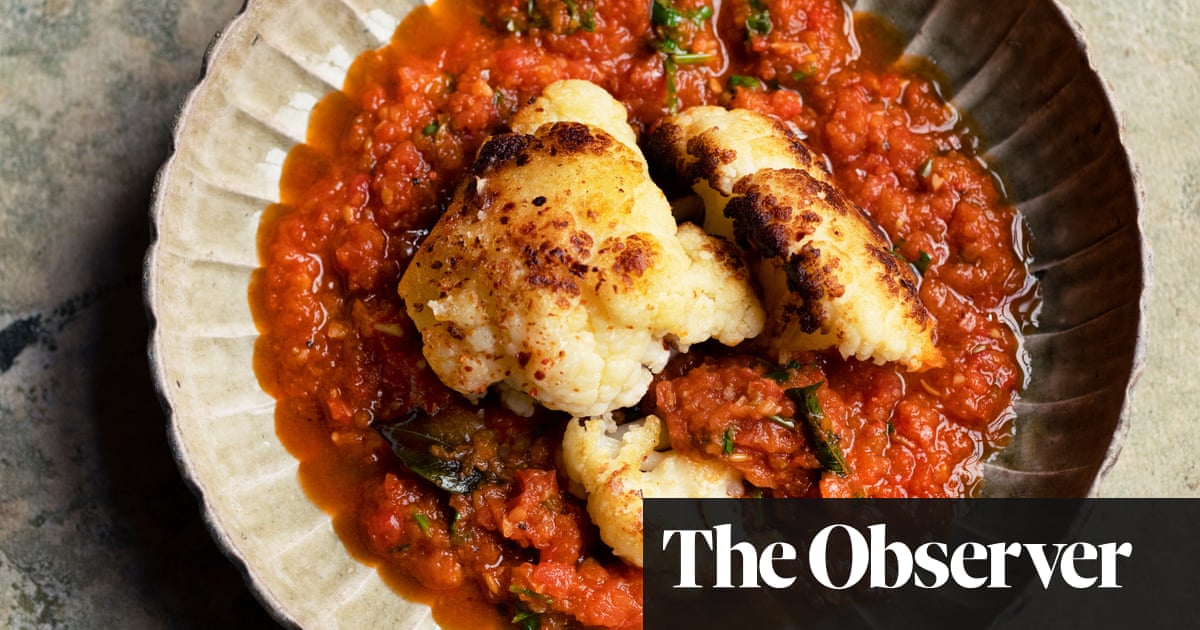
Eagle-eyed readers might recognise Su Scott’s name. In 2019, she won best reader’s recipe at our annual awards with her take on kimchi jjigae, a feel-good stew. The award was a turning point for Scott who wrote a food blog and now lives in London but, back then, didn’t cook that much Korean food.
“Making my mum’s kimchi stew, which my father liked, I remember thinking, ‘I can be proud of this. This is what makes me Korean, and I need to find out more,’” says Scott, whose debut cookbook, Rice Table, is published in March.
Kimchi jjigae was part of a more complex story. In 2019, Scott was struggling with loneliness. She had moved to London in 2000 but had come to feel she was a foreigner both in the UK and in Korea.
After her daughter, Kiki, was born in 2015, Scott experienced postnatal depression: “When you’re in that fragile mindset, a lot of questions start to arise. I found cooking as a way of controlling my collapsing world.”
Dishes from childhood are at the heart of Rice Table. Scott wanted to preserve them for Kiki when she was older. “Being a mum and raising a dual-heritage child, I got scared of memories fading. If I don’t remember something, no one’s going to.”
Black bean sauce noodles – jjajangmyeon (pictured above)
Jjajangmyeon is a popular Korean-Chinese dish which has established itself as one of the most convenient delivery meals of all time in Korea.
Sweet vegetables are essential for it to work its magic; to balance the richness of the pork and salty chunjang – a Korean style of black bean paste made from fermented soybeans, which can be found in Asian grocers or online. In its raw state, chunjang tastes slightly bitter and sour, so fry off the paste in oil before cooking to bring out a more rounded flavour.
Serves 2 generously
vegetable oil 4 tbsp
chunjang (Korean black bean paste) 4 tbsp
spring onions 2, white parts only, thinly sliced
garlic 2 cloves, finely minced
ginger root ½ tsp, grated
pork shoulder or belly 150g, diced
sea salt flakes
onions 2 small, diced
white cabbage 150g, diced
courgettes 70g, diced
golden granulated sugar 1 tbsp soy sauce 1 tbsp
oyster sauce 2 tsp
warm chicken stock or water 250ml
water 1 tbsp
potato flour 1 tsp
wheat noodles 2 servings
For the toppings
cucumber 60g, cut into julienne strips
soft-boiled egg 1, halved
fine chilli flakes pinch (optional)
Place the vegetable oil and chunjang in a cold wok or sauté pan over a low heat to slowly warm them up together. Stir constantly and fry the paste for about 3 minutes, until bubbles surface on top. You will notice the funky and salty smell of the paste. Once done, separate the fried paste and oil – you should have about 2½ tablespoons of oil. Set both aside. The oil will be used to cook the onions.
Wipe down the pan and heat the reserved oil. Stir in the sliced spring onion whites and cook for 1-2 minutes over a medium heat until they sizzle and smell fragrant. Add the garlic, ginger, pork and a good pinch of salt, and stir-fry for about 3 minutes to brown the pork, while energetically moving the pan to stop the alliums from burning.
Once the pork has browned, crank up the heat and add the onions. Stir-fry the onions over a high heat for a couple of minutes to soften and caramelise. The onions should still have a little bite to them and not be completely mushy.
Add the cabbage and courgette to the pan and continue cooking for a further 3 minutes, or until the vegetables are softened.
Stir in the sugar, then carefully pour the soy sauce around the edge of the wok to season the onions. Add the reserved, fried chunjang and the oyster sauce. Continue tossing and stirring vigorously to loosen and mix the paste in with the onions. After a couple of minutes, the onions should be well coated. Add the stock or water. Bring to the boil, then reduce the heat and simmer for 5 minutes.
Meanwhile, combine the tablespoon of water with the potato flour to make a slurry. Maintain the gentle heat and gradually stir in the slurry to thicken the sauce slightly – I find about 2 teaspoons are enough for a ragu-like consistency. Cook for a minute or two to bring it all together. Check for seasoning and adjust it with a pinch more salt and sugar, if necessary.
Cook the noodles according to the packet instructions. Divide the noodles between two bowls and ladle the warm black bean sauce over the noodles. Top with julienned cucumber, the boiled egg and pinch of chilli flakes, if using.
Grilled salt- and sugar-cured mackerel – jaban godeungeo gui
Grill over the embers of coals, if weather permits, otherwise slide under the grill until the skin chars and blisters. Serve with anise-pickled rhubarb or a squeeze of lemon.
Serves 2, or 4 as a starter
mackerel 2, heads removed, cleaned and butterflied, or 4 fillets
sea salt flakes 2 tsp
golden granulated sugar 2 tsp
sake 1 tbsp
vegetable oil 1 tbsp
lemon wedges to serve
Pat the fish dry with kitchen paper and lay them on a tray in a single layer, skin-side down. Sprinkle evenly with half the salt and sugar, then turn over and sprinkle with the rest of the salt and sugar.
Refrigerate uncovered for at least 1 hour and up to overnight. Preheat the oven grill on high. Line a shallow baking tray with foil and place it in the oven to heat. When the fish is laid on the hot tray, it will start to cook immediately from top and bottom. Combine the sake and vegetable oil in a bowl. Remove the mackerel from the fridge and gently brush the sake and oil mixture on both sides.
Carefully remove the foil-lined tray from the oven, which should be hot. Place the mackerel skin-side up and grill on high for about 4 minutes until the skin chars and blisters in places. There is no need to flip to cook the flesh side – it should be perfectly cooked.
To serve, transfer to individual plates with wedges of lemon on the side.
Anise-pickled rhubarb – rhubarb cho jeorim
The tart rhubarb laced with sweet orange and star anise has an almost floral sweetness.
Makes enough to fill a 700ml sterilised heatproof container
rhubarb 400g
water 200ml
white granulated sugar 100g
sea salt flakes 1 tsp
fresh orange peel 2 strips
star anise 2
cider vinegar 100ml
To prepare the rhubarb, cut the stalks into 5cm-long batons, then halve each one lengthways to cut it into thin strips. Transfer the stripped rhubarb into a sterilised, heatproof jar or container.
Put the water, sugar and salt into a small saucepan. Whisk together to combine and add the orange peel and star anise. Bring to a gentle simmer over a low heat until the sugar has fully dissolved – this takes about 4 minutes.
Once hot, stir in the vinegar, then warm the liquid up for a minute so the brine is hot but not boiling.
Remove from the heat and pour over the rhubarb, pressing down gently to submerge in the brine. Put on the lid, leaving it ajar so everything cools down a little, before securing the top.
Let the pickle sit at room temperature, away from the direct sun, for one day, then transfer to the fridge. The pickles will be ready to eat after two days, and they will keep well in the fridge for two weeks.
Curried pot rice – kare sotbap
This is an ode to the bright yellow Korean curry that my mother used to make with ready-made ottogi curry powder. Eat with kimchi.
Serves 4
white short-grain rice 300g
water or chicken stock 300ml
soy sauce 1 tbsp
coriander seeds 1 tbsp
cumin seeds 1 tsp
black peppercorns ½ tsp
fenugreek seeds ¼ tsp
Kashmiri chilli powder ½ tsp
ground turmeric 1 tsp
vegetable oil 2 tbsp
onion ½, thinly sliced
unsalted butter 20g
garlic 3 cloves, finely minced
tomatoes 200g, skinned and roughly chopped
golden granulated sugar 1 tsp
sea salt flakes 2 tsp
frozen peas 100g
To finish
snipped chives 2 tsp
Place the uncooked rice in a mixing bowl and wash thoroughly (see note below). Once the water starts to run clear, fill the bowl with cold water and soak the rice for 30 minutes, then drain using a fine sieve. Mix the water or stock with the soy sauce.
Meanwhile, place the coriander seeds, cumin seeds, black peppercorns and fenugreek seeds in a small saucepan and dry roast over a low heat for a minute or so. Swivel the pan around a little to keep the spices moving. It should smell very fragrant but not burnt. Once the whole spices are roasted, grind them to a fine powder using either a spice grinder or a mortar and pestle. Stir in the chilli powder and turmeric. Set aside.
Heat the vegetable oil in a heavy-based, lidded saucepan over a low heat. Add the onions, a good pinch of salt and sauté gently, stirring frequently, for about 10-15 minutes. The onions should be floppy and beautifully caramelised, with the edges catching a little colour. If you feel it is cooking too fast, add a tiny splash of water.
Once the onions are jammy, melt in the butter. Stir in the garlic and spice mix, and cook for a minute or two so the garlic and spices can soften into the caramelised onion. Add the tomatoes, sugar and salt, then cook for 5 minutes. Stir in the drained rice, and water and soy sauce. Put the lid on and simmer for 10 minutes over a low-medium heat.
Turn the heat down as low as it can go. Add the peas on top. Put the lid back on and cook for a further 8 minutes to steam. Turn off the heat and let it sit for 10 minutes with the lid firmly left on.
Once 10 minutes are up, open the lid and give it a gentle stir with a rice paddle or wooden spoon to mix it all up – notice the slightly crunchy crust at the bottom of the pan. Divide the rice between bowls and scatter with snipped chives. Serve while warm.
Note on washing rice
I learned to scrub rice anti-clockwise three times and rinse it three times more.
For two servings, put 150g of short-grain white rice into a bowl of cold water and swish around quickly to separate the sitting dust or debris that will float to the surface. Drain off the water and repeat. After you have drained off the water for the second time, gently rub the grains to separate, then add water to rinse. Drain the starchy water carefully and repeat two more times. The water in which you rinse the rice will change from milky white to more translucent but not completely clear (more like the colour of coconut water) as you repeat the process. During the winter, washing rice can feel extremely cold and uncomfortable. One tip I’ve picked up along the way is to use a large balloon whisk instead – it also helps if you’re not so sure how to rub the grains gently enough but also effectively.
Sweet and sour tofu – dubu tangsu
Tangsuyuk is one of many quintessential Korean-Chinese dishes which use lean strips of pork. Dredged in starchy batter, the meat has a crisp exterior that doesn’t go sweaty, even when doused in velvety sweet-and-sour sauce. I am opting for tofu here as I tend to have a block sitting in the fridge, which makes for a great meat-free weeknight dinner.
Serves 2
firm tofu 396g block
fine sea salt
potato flour 3 tbsp
cornflour 2 tbsp
vegetable oil for frying
For the sauce
golden granulated sugar 2 tbsp
cider vinegar 2 tbsp
tomato ketchup 1 tbsp
soy sauce 1 tbsp
ginger root 1 tsp, grated
water 150ml
lemon ½, sliced
ground cinnamon a pinch to taste
water 1 tbsp
potato flour 1 tsp
To finish
toasted black sesame seeds ½ tsp
Pat the tofu dry with kitchen paper, then cut into 2.5cm cubes. It is easy to do this by cutting the tofu in half down the middle, then quartering each block again before finally cutting into cubes. Lay the tofu cubes on a tray lined with a sheet of kitchen paper to soak up excess moisture. Salt them generously and leave to stand for 10 minutes.
Meanwhile, for the sauce, combine the sugar, cider vinegar, ketchup, soy sauce, ginger and water in a small mixing bowl. Set aside.
Put the potato flour and cornflour in a bowl or large reusable plastic bag. Add the salted tofu cubes and coat them by tossing or shaking with the top sealed, if you’re using the bag. Let it sit for a couple of minutes.
Prepare a cooling rack set over a roasting tray. Fill a large, heavy-based saucepan with vegetable oil deep enough to submerge the tofu but do not fill the pan more than three-quarters full.
Heat the oil to 175C. Gently lower a few of the tofu pieces into the oil, so they have plenty of room to fry and don’t reduce the oil temperature too much. Fry for 5 minutes until they are evenly golden and crisp on all sides. Transfer them onto the cooling rack. Continue to cook in batches.
Put the prepared sauce mixture in a wok and bring it up to a rapid boil over a high heat. You will notice large bubbles gathering on the surface. Continue to boil for about 3 minutes so the sauce reduces down and thickens slightly. Add the sliced lemon and the pinch of cinnamon.
Reduce the heat. Combine the water and potato flour to make a slurry, then gradually add to the sauce (about two thirds of it to start with) until it is shiny and the consistency of clear honey. You may not need all the slurry.
Once the sauce has thickened to the desired consistency, toss in the fried tofu and stir to coat. Scatter with the black sesame seeds and serve immediately while warm.
Old-school pork cutlet – yetnal donkkaseu
This old-school pork cutlet, also known by the Japanese name tonkatsu, was first introduced to Korea during the Japanese occupation and is believed to trace its roots right back to Europe: think Italian veal Milanese, French escalope or German schnitzel.
While Japanese-style tonkatsu in Korea remains thick and is always served sliced, Korean iterations take thinner slices of lean pork, typically cut from the loin. Pork prepared by butchers is flattened and tenderised by a machine that indents the flesh, leaving the iconic, uniformed lines of marks which prevents the meat from curling.
I like to use a meat mallet to flatten the pork and a needle-bladed meat tenderiser to achieve a similar effect. You can use a rolling pin or the back of the knife to flatten and tenderise but, if neither is available to you, make sure you make a few small cuts to stop the meat from curling when fried.
Serves 2
pork loin steaks 2 (150g), trimmed
onion ½, roughly chopped
whole milk 3 tbsp
garlic powder ½ tsp
sea salt flakes ½ tsp
plain flour 3 tbsp
egg 1, whisked with a pinch of salt
panko breadcrumbs 100g
vegetable oil for frying
For the sauce
golden granulated sugar 1 tbsp
tomato ketchup 2 tbsp
Worcestershire sauce 2 tbsp
soy sauce 2 tsp
English mustard 1 tsp
unsalted butter 10g
plain flour 2 tbsp
water 300ml
freshly cracked black pepper ½ tsp
full-fat milk 3 tbsp
sea salt flakes to taste
To finish
white cabbage 120g, shredded
Worcestershire sauce generous splash
extra virgin olive oil generous splash
salt and pepper good pinch
Prepare the pork slices by flattening and tenderising with any of my chosen tools (see intro), so the slices are about 1 cm thick. Use clingfilm or a reusable bag to protect the flesh of the pork when flattening. Work through both pieces.
Place the onion and milk in a food processor and blend until smooth. Stir in the garlic powder and salt. Pour over the tenderised pork and refrigerate for 30 minutes.
Meanwhile, combine the sugar, ketchup, Worcestershire sauce, soy sauce and English mustard in a bowl. Mix well and set aside.
Continuing with the sauce, melt the butter in a heavy-based saucepan and add the flour. Cook the flour over a low–medium heat for 3–4 minutes, stirring constantly, until the mixture turns toffee brown in colour, making sure you don’t let it burn.
Carefully pour in the water a little at a time, whisking constantly to keep it smooth. Add the ketchup mixture to the pan and season with the black pepper. Combine well and simmer gently for about 15 minutes to reduce, stirring occasionally.
Stir in the milk and season with a pinch of salt, if necessary. Simmer for 5 minutes to thicken slightly – the sauce should have a pourable consistency. Keep warm until needed.
Remove the pork from the fridge. Scrape off as much of the marinade as possible and pat the meat dry with kitchen paper. Have three shallow, rimmed plates or trays ready: one filled with the flour, one with the eggs and one with the panko breadcrumbs.
Spray the breadcrumbs with a little water to moisten.
Keep one hand for the egg and the other for handling the dry ingredients. Lightly dust the pork with flour, dip into the whisked egg, then push into the breadcrumbs gently but firmly until evenly coated. Repeat with the other piece and set aside.
Prepare a cooling rack set over a roasting tray.
Fill a large, heavy-based saucepan, or large frying pan suitable for deep-frying, with vegetable oil. Ideally, it should be filled deep enough to submerge the pork cutlets but, if not, remember to flip the cutlets halfway through to ensure even cooking. Heat the oil to 160C. Add the cutlets one at a time and fry for 4 minutes, until golden and cooked through. When ready, transfer to the cooling rack. Any excess oil will drip down.
Toss the cabbage in a bowl with the Worcestershire sauce, olive oil and seasoning.
Divide the pork cutlets between two individual plates without slicing. Pour the warm brown sauce generously over the top. Serve with shredded cabbage salad.












